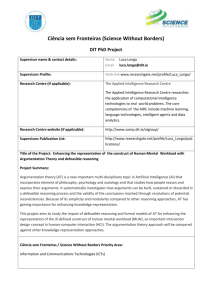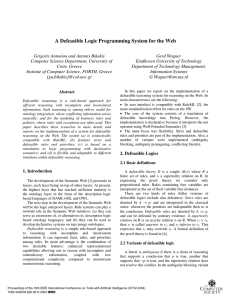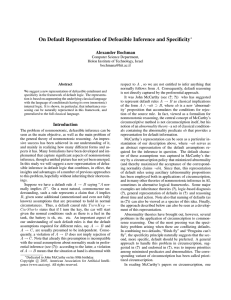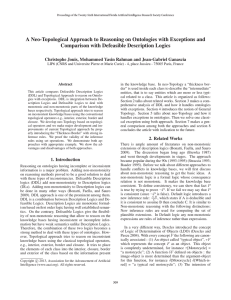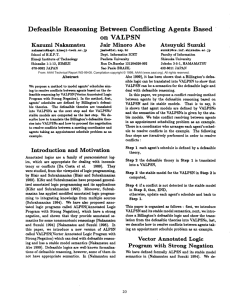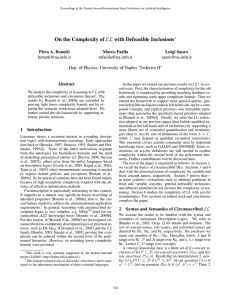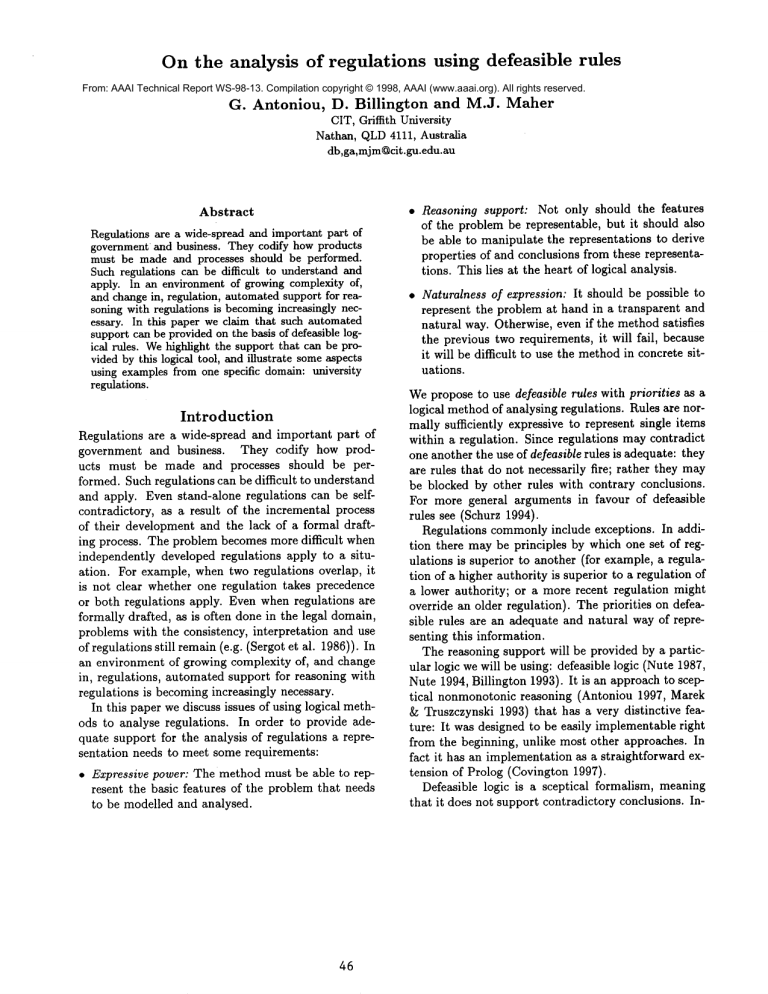
On the analysis
of regulations
using defeasible
rules
From: AAAI Technical Report WS-98-13. Compilation copyright © 1998, AAAI (www.aaai.org). All rights reserved.
G. Antoniou,
D. Billington
and
CIT, Griffith University
Nathan, QLD4111, Australia
db,ga,mjm~cit.gu.edu.au
Abstract
Regulations are a wide-spread and important part of
governmentand business. They codify how products
must be made and processes should be performed.
Such regulations can be difficult to understand and
apply. In an environment of growing complexity of,
and change in, regulation, automatedsupport for reasoning with regulations is becomingincreasingly necessary. In this paper we claim that such automated
support can be providedon the basis of defeasible logical rules. Wehighlight the support that can be provided by this logical tool, and illustrate someaspects
using examplesfrom one specific domain: university
regulations.
Introduction
Regulations are a wide-spread and important part of
government and business. They codify how products must be made and processes should be performed. Such regulations can be difficult to understand
and apply. Even stand-alone regulations can be selfcontradictory, as a result of the incremental process
of their development and the lack of a formal drafting process. The problem becomes more difficult when
independently developed regulations apply to a situation. For example, when two regulations overlap, it
is not clear whether one regulation takes precedence
or both regulations apply. Even when regulations are
formally drafted, as is often done in the legal domain,
problems with the consistency, interpretation and use
of regulations still remain(e.g. (Sergot et al. 1986)).
an environment of growing complexity of, and change
in, regulations, automated support for reasoning with
regulations is becomingincreasingly necessary.
In this paper we discuss issues of using logical methods to analyse regulations. In order to provide adequate support for the analysis of regulations a representation needs to meet some requirements:
¯ Expressive power: The method must be able to represent the basic features of the problem that needs
to be modelled and analysed.
46
M.J.
Maher
¯ Reasoning support: Not only should the features
of the problem be representable, but it should also
be able to manipulate the representations to derive
properties of and conclusions from these representations. This lies at the heart of logical analysis.
¯ Naturalness of expression: It should be possible to
represent the problem at hand in a transparent and
natural way. Otherwise, even if the method satisfies
the previous two requirements, it will fail, because
it will be difficult to use the methodin concrete situations.
Wepropose to use defeasible rules with priorities as a
logical methodof analysing regulations. Rules are normally sufficiently expressive to represent single items
within a regulation. Since regulations may contradict
one another the use of defeasible rules is adequate: they
are rules that do not necessarily fire; rather they may
be blocked by other rules with contrary conclusions.
For more general arguments in favour of defeasible
rules see (Schurz 1994).
Regulations commonlyinclude exceptions. In addition there maybe principles by which one set of regulations is superior to another (for example, a regulation of a higher authority is superior to a regulation of
a lower authority; or a more recent regulation might
override an older regulation). The priorities on defeasible rules are an adequate and natural way of representing this information.
The reasoning support will be provided by a particular logic we will be using: defeasible logic (Nute 1987,
Nute 1994, Billington 1993). It is an approach to sceptical nonmonotonic reasoning (Antoniou 1997, Marek
& Truszczynski 1993) that has a very distinctive feature: It was designed to be easily implementable right
from the beginning, unlike most other approaches. In
fact it has an implementation as a straightforward extension of Prolog (Covington 1997).
Defeasible logic is a sceptical formalism, meaning
that it does not support contradictory conclusions. In-
stead it seeks to resolve differences. In cases whereit
is impossible to decide whether to conclude A or --,A,
the logic does not conclude either of them (thus the
name "sceptical"). Sceptical reasoning is appropriate
for the study of regulations. Users of regulations are
mostly interested in getting correct advice without being confronted with conflicting views.
Basics of Defensible
Logic
A set of regulations will be represented as a defensible
theory. A defensible theory1 consists of four different
kinds of knowledge:facts, strict rules, defensible rules,
and a superiority relation.
Facts denote simple pieces of information that are
deemedto be true regardless of other knowledgeitems.
A typical fact is that Tweetyis a bird: bird(tweety).
Strict rules are rules in the classical sense: whenever
the premises of a rule are given, we are allowed to apply
the rule and get a conclusion. Whenthe premises are
indisputable (e.g. facts) then so is the conclusion.
example of a strict rule is "Emusare birds". Written
formally:
emu(X) --+ bird(X).
Defeasible rules are rules that can be defeated by contrary evidence. An example of such a rule is "Birds
typically fly"; written formally:
bird(X) :¢, flies(X).
The idea is that if we knowthat something is a bird,
then we mayconclude that it flies, unless there is other
evidence suggesting that it may not fly.
The superiority relation amongrules is used to define priorities amongrules, that is, whereone rule may
override the conclusion of another rule. For example,
given the defensible rules
r:
r’:
Examples:
University
regulations
Example 1: Academic misconduct
A typical rule found in university regulations is the
following, taken from the Griflith University policy on
academic misconduct:
Where a student has been found guilty of academic misconduct on more than one occasion and
has previously been penalised as set out in 3.1 3.3 above, the penalty shall normally be exclusion
from the course, unless in the opinion of the relevant Assessment Board there are mitigating circumstances.
This is a typical rule with exceptions. In the framework we are proposing, we would represent this rule as
follows:
rl : guilty,
exclude
repeat, previouslyPenalised
r~ : mitigatingCircumstances ~ -.exclude
r2 > rl
Notice that the predicate mitigatingCireumstanees
will only be established if the Assessment Board decides so. Then a fact wouldbe added to this particular
case, and the decision would be not to exclude. This
exampleillustrates the representation of exceptions in
defensible logic: Both the general rule and the exception are formalised as defeasible rules. The exception
is stronger than the general rule (in case the exception
rule is applicable, of course).
Example 2: Guidelines
on fees
The second example is more substantial.
It comprises part of the Griffith University guidelines on fees.
bird(X) ~ flies(X)
brokenWing(X)
~-,flies(X)
which contradict one another, no conclusive decision
can be made about whether a bird with a broken wing
can fly. But if we introduce a superiority relation >
with r ~ > r, then we can indeed conclude that it can’t
fly.
It turns out that we only need to define the superiority relation over rules with contradictory conclusions. Also notice that a cycle in the superiority relation is counterintuitive from the knowledgerepresentation perspective. In the above example, it makes no
sense to have both r > r ~ and r ~ > r. Consequently,
the defensible logic we discuss requires an acyclic superiority relation.
l a knowledgebase in DefeasibleLogic
47
1.1 The University may not charge tuition fees for Australian students in undergraduate award courses.
1.2 The University may charge fees for postgraduate
courses.
1.3 Overseas students are generally fee paying but there
are some exceptions. There is minimumfee level
set by the Governmentfor fees for overseas students
(FPOS). There are special arrangements for international exchange students. Refer to the GUInternational Center for advice on these issues.
1.7 All students are liable for HECS(Higher Education Contribution Scheme)with very few exceptions.
Students who do not pay HECSinclude:
-
FPOS students
fee paying postgraduate students
non-award students
students with an APA(Australian postgraduate
award)
- students wholly sponsored by an employer.
Here is the representation of this information in defeasible logic:
rl. 1 : student, australian, undergrad~ ",fee
rl.2 : student,postgrad :=~ fee
student, overseas, ezchange
3. Anomaly detection: Formal methods can be used to
detect anomalies such as inconsistency, incompleteness and circularity. In defeasible logic, such anomalies are detected either by static analysis, or by the
performance of the proof theory, for example by the
proof of some facts regarding non-derivability (for
technical details see (Antoniou et al. 1998)).
rl.Te : student, APA:ez ",H ECS
rl.71 : student, fullySponsored =:~ -,H ECS
4. Hypothetical reasoning: It is possible to investigate
the effects of changes to regulations on the entire
regulatory system. This is possible since a defeasible
knowledgebase is an executable specification.
> rl.Sb
rl.7b > rl.7a
rl.Te > rl.Ta
5. Debugging: In many eases we know what the answer
to a specific query should be, yet the regulations in
their current form lead to a different answer. Debugging suggest changes to the regulations which will
have as an effect the desirable outcome. In defeasible logic, debugging can be carried out along the
lines of "declarative debugging" (Naish 1997).
rl.Td > rl.7a
rl.7e
> rl.7a
rl.7]
~> rl.7a
Example 3: Hierarchies
2. Explanation: Whenan answer is given, there is also
a reasoning chain explaining this response. This can
be most helpful in help desks etc.
=~
rl.7a : student :=~ HECS
rl.7b : student, payF POS:~ -~H ECS
rl.7 c : student, postgrad, .fee =~",HECS
rl.7 d : student, nonAward =~ -,HECS
rl.Se
1. Decision support: It is possible to run a specific case
with the given regulations to get a correct answer.
Being a logical approach, defeasbile logic provides this
kind of support. Drafting regulations can be supported
in the following ways:
rl.sa : student, overseas ::~ fee
rl.3b : student, overseas ==~payFPOS
rl.3c
:
",payFPOS
Regarding the understanding and application of regulations, formal systems have the following advantages. These advantages are important, for example,
for "naive users/subjects of regulation" whoare regulated but do not wish to study the regulations.
of regulations
Often regulations themselves are organised in a hierarchical fashion. For exampleon top of the Griffith
University regulations there exist public service regulations which, if a conflict should arise, are stronger
than university regulations.
Defeasible logic supports this structure in a natural
waythrough its superiority relation: It is straightforward to encode the information that rules in a particular regulation are stronger than rules in another
regulation.
How can
formal
methods
support
the
analysis
of regulations?
The use of formal representation and reasoning methods is beneficial for regulatory reasoning in various
ways. In the following we distinguish between drafting
regulations, and understanding and applying regulations.
48
Conclusion
Regulations play an important role in the organisation
and functioning of society in general, and business in
particular. Wepointed out that the increasing complexity of regulations and the frequency of necessary
changes, mainly due to technological change and the
current trend towards globalisation, make automated
support in the analysis of regulations necessary. In this
paper we argued in favour of a particular method, defeasible logic, whichrepresents information in the form
of rules and a priority relation. Weused examplesfrom
university regulations to illustrate the adequacyof this
representation.
Of course there is still a lot of workto be done in this
area. One particular avenue we intend to explore in the
near future is to build an argumentation support system for regulatory reasoning - a reasoning assistant.
This system will provide the analytical support outlined in this paper, and will do so in a user-friendly
way.
Acknowledgements
This work is being supported by an ARCLarge Research Grant.
References
G. Antoniou (1997). Nonmonotonic Reasoning. MIT
Press.
G. Antoniou, D. Billington and M.J. Maher (1998).
Normal Forms for Defeasible Logic. In Proc. Joint International Conference and Symposium on Logic Programming(accepted).
D. Billington (1993). Defeasible Logic is Stable. Journal of Logic and Computation 3: 370-400.
M.A. Covington, D. Nute and A. Vellino (1997). Prolog Programmingin Depth. Prentice Hall.
V. Marek and M. Truszczynski (1993). Nonmonotonic
Logic, Springer.
L. Naish (1997). A Declarative Debugging Scheme.
Journal of Functional and Logic Programming3.
D. Nute. Defeasible Reasoning (1987). In Proc. 20th
Hawaii International Conference on Systems Science,
IEEE Press, 470-477.
D. Nute (1994). Defeasible Logic. In D.M. Gabbay,
C.J. Hogger and J.A. Robinson (eds.): Handbook of
Logic in Artificial Intelligence and Logic Programming
Vol. 3, OxfordUniversity Press, 353-395.
G. Schurz (1994). Nonmonotonic Reasoning and
Changes of Belief. In P. Weingartner (Ed.), Scientific and Religious Belief, Special Issue of Philosophical Studies Series, volume59, Kluwer, 47-64.
M.J. Sergot, F. Sadri, R.A. Kowalski, F. Kriwaczek, P.
Hammond
and H.T. Cory (1986). The British Nationality Act as a Logic Program. Communicationsof the
ACM29,5,370-386.

